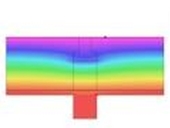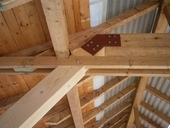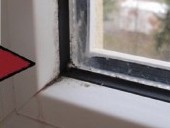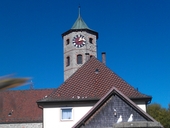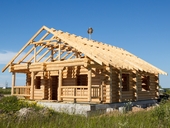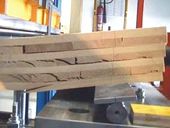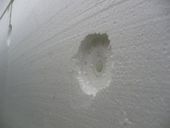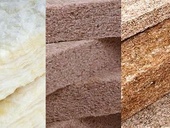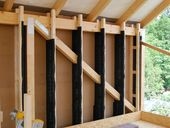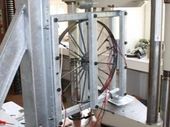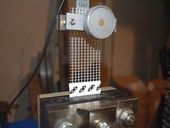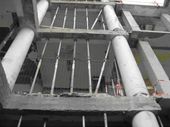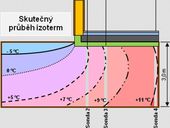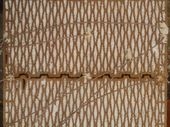Thermal bridges are important spots of heat loss of buildings, and therefore must be taken into account. Size of the thermal bridges can be obtained either by calculation or from catalogs. One of them is the electronic catalog of thermal bridges, which is sold by KCAD.
Archiv článků od 22.7.2013 do 27.9.2013
The paper is concerned with some selected defects and failures of timber structures and their rehabilitation. The paper summarises some conclusions from the construction and real behaviour of selected timber systems. Due to the fact that their load-carrying capacity and deflections are considerably affected by the load-carrying capacity of the joints, it was de-sirable to verify the influence of structural design of fasteners and connectors on the over-all behaviour of structural systems. Findings from behaviour of structures after their reha-bilitation are crucial for further research into real behaviour of timber structures.
This paper deals with the time period of condensation on the inner surface during the day and the severity of this phenomenon. Condensation on the surface structure occurs when the surface is cooled to or below the dew point temperature, which is a function of temperature, relative humidity and atmospheric pressure.
The article describes what a National Heritage Institute, its scope, location of sites and activities. The following are types of divided heritage protection, (cultural monument, national monument, conservation). In conclusion, described the law on state conservation), obligations for owners and likes the cultural monuments.
The work describes the divisions of contemporary and traditional solid wood constructions. The introduction briefly explains the historical development of timber structures and the advantages that these structures provide. Individual structural systems are described according to the basic elements and usage possibilities. The requirements for the massive wooden houses are listed in the form of technical standards and laws that have to meet.
This paper deals with the basics of the so-called “Massive Timber Construction“ (MTC) system. The paper is focused to the design of MTC system (mainly design of floors, shear walls and connections) which is made from the relatively new wood-based product “Cross Laminated Timber” (CLT). CLT consists of several layers built-up with boards. Their assembly in orthogonal directions allow them to produce elements with big dimensions. Currently, no regulations for the design of CLT-elements are given in the European standards. Nevertheless mechanical parameters of CLT-elements can be determined on the basis of the properties of the single layers as is shown in the paper. It is expected that CLT will play an important role in the future use of wood in single and multi-storey buildings.
Thermal stability of rooms affects the local characteristic of the area, building geometry, orientation to the cardinals, the ability of heat storage, mean and intensity of ventilation, and also the size and properties of transparent parts of facade along with their shading. The most effective way to prevent the overheating of the room is to reduce heat gains through transparent structures by shading. Shading by overhanging structures is expressed by sunlit factor fs. This factor changes during the day, with the movement of the sun, and thus the determination for calculations is difficult. This paper deals with a comparison of two different methods of calculation, their comparison and the final comparison with the measured data.
This paper deals with possibility of using recycled construction and demolition waste as aggregate for concrete. The European Standards describes tests and properties of recycled aggregate for concrete. The main aim of this investigation was determination of recycled aggregates properties and their comparing with properties of natural aggregate and requirements in Standards. Selected geometrical and physical properties were tested and results were used to design concrete mixture. It was found that the main differences between natural and recycled aggregate is water absorption. Water absorption of recycled aggregate was more than ten times higher.
Measurement of short term water absorption and thermal conductivity was carried out on samples of traditional insulation and the insulation samples from natural fibers. Further, the measured change in thermal conductivity after soaking and subsequent drying of the original weight.
The results showed that the thermal insulation of natural materials retain their original properties – thermal conductivity, shape, compared to conventional insulation.
The article deals with sound insulation of wooden house constructions, including the national requirements for sound insulation of walls. There is also a brief description of the laboratory measurement of the sound insulation of wall constructions and information about the sound insulation of single and double wood-based structures.
A new type of circular wind bracing has been developed for stiffening of high-rise slender steel structures. This bracing can use pre-stress to modify its stiffness to achieve required properties. The models scalled 1/20 are subject to static and dynamic load laboratory tests in order to prove theoretical conclusions and to adjust optimal values of pre-stress.
The term “ancillary materials” covers a wide range of products (mouldings, profiles etc.) which significantly influence the overall quality of works. As legislation normally does not require any verification of performance and no relevant standards exist, verification and declaration of performance is usually omitted. In reaction to that, we have specified characteristics and verification methods for adequate and consistent verification of relevant characteristics in the framework of voluntary certification.
Every construction project passes through its life cycle, from initial idea, through the design, implementation, or to change the construction and use to disposal. Article highlights the interdependence of the life cycle of buildings with durability and amortization of buildings and does not omit important perspective on this issue, which is the economic expression of the parts of individual cost items arise during the life cycle.
From the 1st January 2013 new legal and technical regulations are coming in force, which have an impact on higher requirements on energy use for heating and this way also on energy use for heating and cooling. These requirements are stricter not only on the new, but also on major renovated buildings. Proposed measures must fulfil hygienic and energy requirements set by STN 73 0540-2: 2012. Calculated thermal protection properties of building structures are influenced by the properties of used components. Conformity of achieved real properties with the design of building depends from the accuracy of components properties, their real quality and quality of the installation. The design values for construction materials (products) are set in STN 73 0540-3: 2012.
Existing procedures for determining heat transfer in the soil. Temperature measurements in the soil under the floor of the experimental house MSDK at the Technical University in Ostrava. The difference between the calculated temperatures and actually measured. Theoretical and real temperature field in the soil.
Recently broad media in the Czech Republic coverage on hazards from PV systems to fire fighters. Similar situation was in Germany two years ago. That is why Fraunhofer-Institut für Solare Energiesysteme ISE together with TÜV Rheinland and other partners implemented a research project „Assessment of fire risks in PV systems and development of safety concepts for risk mitigation“. The project concluded that the fire risk of PV system is much less than it is publicly alleged in Germany.
There is a small risk that fires can be started by PV components. This risk can be reduced by careful installation, initial verification i.e. inspection and testing, periodic verifications, (yield) monitoring to detect degradation problems, and verification of test procedures and maintenance requirements for conventional AC- components. Overall conclusion is that PV systems are not maintenance free.
Whole presentation from EU PVSEC (in English).
Blocks for masonry with integrated insulation material are known over 30 years. Especialy hollow clay bricks have low U value due to optimalization of their geometry with low thermal conductivity of ceramic body. Finaly integrated insulation material into the holes in bricks results to increasing of thermal insulation properties. Article is focus on behavior of hollow clay bricks with and without integrated insulation material in dynamic heat load.
zpět na aktuální články
